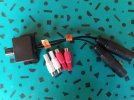This is the review and detailed measurements of the PAC LC-1 passive attenuator. It was kindly purchased new by a member and costs just $9.50 including shipping from Amazon.
View attachment 207656
I must say for such a cheap device, the RCA cables feely nice and supple. And volume control itself is smooth. Inside there is a tiny PCB where all the cross connections are made. From documentation it seems that it is for car stereos but obviously you can also use it for home audio as long as all you want is attenuation.
PAC LC-1 Measurements
I used the LC-1 between my Audio Precision APx555 unbalanced input and output across two 6 foot sections of cabling. Here is the dashboard:
View attachment 207657
So at this volume level, performance is completely transparent. Let's see how good channel separation is:
View attachment 207658
So there is a distinct hit but it is still more than good enough for most things.
The issue with passive volume controls is that it messes with the impedance of the device you are connecting to. This in turn causes a frequency response error as you can see below:
View attachment 207659
The level of attenuation may be worse in your device. As is, it is not too bad at roughly 1 dB at 20 kHz.
What I didn't like is the taper that they selected. Most of the range is useless as you only get meaningful attenuation once you are below 12:00 o'clock. That accentuates the channel differential in the pot used:
View attachment 207660
Of course your example may be worse or better than this. Company rates the unit at ± 8 dB. Not sure how you get +8 dB from a passive control. Assuming they only mean -8 dB, then they are meeting spec.
Conclusions
A passive volume control is going to be bring its native problems so there is no getting around that. In that context, for less than $10, you are getting what looks like a high quality little box and cabling. Yes, the box is plastic but still, I like the total package and am going to recommend the PAC LC-1.
---------
As always, questions, comments, recommendations, etc. are welcome.
Any
donations are much appreciated using
: https://www.audiosciencereview.com/forum/index.php?threads/how-to-support-audio-science-review.8150/

